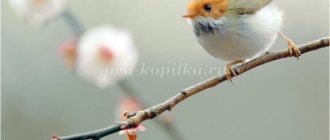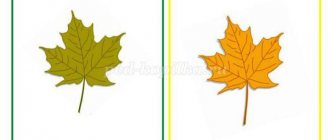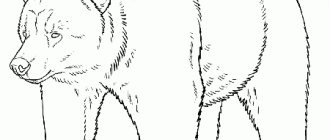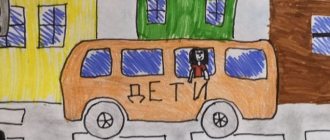On the topic: methodological developments, presentations and notes
Goal: To make children want to do the work (the image of a fairy-tale bird); encourage them to create a variety of images, using different means of expression (color of plumage, different shapes of beak, tail.
Program tasks: Strengthen the skills of adding and subtracting numbers within 10. Teach children to solve arithmetic problems, put the solution on cards and pronounce notes. Strengthen comparison skills.
Summary of a drawing lesson in the senior group On the topic: “fairy-tale bird” Purpose: To teach children to conceive a fairy-tale image, come up with unusual details for a real image, develop imagination Tasks: ·.
Summary of a lesson on speech development in the senior group.
Learn to sculpt a bird from plasticine using a plastic method, pulling out parts from a whole piece and in a constructive way, observing the location and relationship of body parts, connecting parts, when.
Summary of a drawing lesson in the preparatory group “Migratory Birds”.
Topic: "Chickens". Goal: To introduce children to the technique of palm typing. Learn to add details to an image using a brush. Develop the ability to empathize. Handout
Source
Specific options within the theme “Birds”
According to T. Komarova’s fine arts program, in the preparatory group two lessons are devoted to drawing birds: this is drawing an illustration for the work of Mamin-Sibiryak “The Gray Neck” and “The Magic Bird”. However, the topic of birds is so interesting and multifaceted that the teacher clearly should not limit himself to only this. So, options for the feathered theme could be as follows:
- Owl-owl (a very bright image that can be depicted in different techniques).
- A flock of migratory birds (theme is proposed in autumn or spring).
- Cockerel is a golden comb (can be associated with some fairy tale, for example, “The Cockerel and the Bean Seed” or “The Tale of the Golden Cockerel” by A. S. Pushkin).
- Titmouse (you can draw on November 12 or not far from this date, when people celebrate Titmouse Day).
- Bullfinches on a branch (of course, this theme is offered in winter).
- Swallow (it’s good to connect the image with the fairy tale “Thumbelina”).
- Poultry (poultry yard as an option). A child can simultaneously portray a chicken, a rooster, a duck, a goose, a turkey, or one or the other.
- White-sided magpie.
- Swan on the lake (as a variant of the swan princess of A.S. Pushkin before her transformation into a girl or an illustration for Andersen’s fairy tale “Wild Swans”).
- Kargopol birds (drawing based on folk toys).
- Fairytale bird (Firebird).
Older preschoolers always find collective compositions interesting. The “Magic Bird” work is popular, when each child paints a feather to his own taste, and then a gorgeous tail is assembled from them (the teacher prepares the base in advance - the body of the bird).
Each child paints the feather according to their wishes, and together they make up the original tail of a fairy-tale bird.
Here again, you can take an individual approach and invite some children to color two feathers.
Another option for joint creativity is “Birds at the feeder.” The teacher draws a tree with branches and a feeder, and preschoolers complete the composition with birds.
The theme “Birds” encourages the creation of collective compositions
Summary of a drawing lesson in the senior group “Migratory Birds. Starling" Video
Svetlana Gayazieva
Summary of a drawing lesson in the senior group “Migratory Birds. Starling" Video
Goals: improve skills in depicting birds ; develop creative imagination;
cultivate a caring attitude towards the environment; correctly determine and depict the shape of objects, their proportions; observe the sequential execution of the drawing; cultivate a love for birds.
Materials: Album sheets, gouache, brushes, palette, jars of water, napkins, oilcloths, educational video “ Starling ”.
Preliminary work: viewing illustrations of migratory birds ; reading poems, stories; watching educational videos , bird watching on walks .
Preview:
SUMMARY OF JOINT ACTIVITIES OF TEACHERS AND CHILDREN
IN THE PREPARATORY DRAWING GROUP
"BIRDS FLY SOUTH"
PROGRAM CONTENT: Teach children to sketch birds in motion, conveying the basic shape and main parts. Without drawing the details of the plumage. Practice sketching with one pencil or one paint. Consolidate and expand knowledge about wintering and migratory birds. Cultivate a caring attitude towards birds.
MATERIALS: Landscape sheets tinted with blue-violet color (autumn sky, simple pencils, wax crayons; illustrations depicting birds flying south; reproduction of Stepanov’s painting “The Cranes Are Flying.”
CONNECTION WITH OTHER EDUCATIONAL AREAS: Watching birds while walking, paying attention to their varied movements
I. Finger gymnastics
Visiting the thumb Put the thumbs of both hands up
Came straight to the house: Index and middle,
Nameless and last. Alternately, the called fingers are connected to the thumbs on both hands at the same time
The little finger itself Fingers are clenched into a fist, only the little fingers point upward
He knocked on the threshold. Fists knock on each other
Together fingers are friends,
They cannot live without each other. Rhythmic clenching of fingers into fists
II. Introductory conversation
- Guys, let's remember what time of year it is (Autumn). Right. And what changes occur in nature with the arrival of autumn (Children list the signs of autumn?)
- Well done! Right! But today I would like to talk about birds. Let's remember what birds we have seen and know (Children's answers). Do they all stay with us for the winter (No? What are the names of those birds that are not afraid of the cold and stay here (Winterers? What wintering birds do you know (Sparrow, crow, tit, bullfinch, dove, owl, woodpecker, magpie?
What are the names of birds that fly away to warmer regions (Migratory? Yes. That’s right. What migratory birds do you know (ducks, swans, cranes, swallows, rooks, starlings, cuckoos? Why do you think they fly away (It’s cold for them here) and have nothing to eat?)
- Right. Flying birds have nothing to eat in winter. Many migratory birds eat insects. However, with the onset of cold weather, all insects hide, so birds fly to warmer regions in search of food.
– Look carefully at the illustrations.
Pay attention to how the birds fly. Waders, herons, and ducks fly in a line, in front or in a transverse row. Geese most often fly in a school. Geese, cranes, swans and other large birds fly in an angle, or wedge.
- Guys, let's rest a little. Imagine that you are birds and repeat after me:
Birds jump and fly. They wave their arms and jump up and down
Birds collect crumbs. "Peck"
The beaks were cleaned. Stroke your hands and noses
Birds fly, sing, wave their arms
The grains are pecked. "Peck"
V. Independent activities of children
– Have you rested? Fine! And now I suggest you draw birds flying south. Look what's on your tables (Children's answers? First we will make a sketch with a simple pencil, and then we will outline and color it with wax pencils.
During the practical part, explain to the children that sketches should be drawn with light lines; they need not be finished, not finished to the end; you can leave the failed form and start another; I need to try to make more sketches. The resulting sketches are outlined with a wax pencil.
During the lesson, the teacher analyzes the images created by the children, explains mistakes, and guides them in searching for the correct representation of form and movement.
VI. Lesson summary
At the end of the work, the children attach the drawings to the board. Demonstration of their works by children; choose the most neat and beautiful works with the children.
– Children, what did we do today (Children’s answers? You did well, you all tried your best and you did a good job. Thank you. This concludes our lesson.)
Preview:
GOAL: to teach children to sketch birds in motion, conveying the basic shape and main parts.
Practice sketching with one pencil or one paint. Consolidate and expand knowledge about wintering and migratory birds. Cultivate a caring attitude towards birds.
MATERIALS: Landscape sheets tinted with blue-violet color (autumn sky, simple pencils, wax crayons; illustrations depicting birds flying south; reproduction of Stepanov’s painting “The Cranes Are Flying.”
I. Finger gymnastics
Visiting the thumb Put the thumbs of both hands up
Came straight to the house: Index and middle,
Nameless and last. Alternately, the called fingers are connected to the thumbs on both hands at the same time
The little finger itself Fingers are clenched into a fist, only the little fingers point upward
He knocked on the threshold. Fists knock on each other
Together fingers are friends,
They cannot live without each other. Rhythmic clenching of fingers into fists
II. Introductory conversation
- Guys, let's remember what time of year it is (Autumn). Right. And what changes occur in nature with the arrival of autumn (Children list the signs of autumn?)
- Well done! Right! But today I would like to talk about birds. Let's remember what birds we have seen and know (Children's answers). Do they all stay with us for the winter (No? What are the names of those birds that are not afraid of the cold and stay here (Winterers? What wintering birds do you know (Sparrow, crow, tit, bullfinch, dove, owl, woodpecker, magpie?
What are the names of birds that fly away to warmer regions (Migratory? Yes. That’s right. What migratory birds do you know (ducks, swans, cranes, swallows, rooks, starlings, cuckoos? Why do you think they fly away (It’s cold for them here) and have nothing to eat?)
- Right. Flying birds have nothing to eat in winter. Many migratory birds eat insects. However, with the onset of cold weather, all insects hide, so birds fly to warmer regions in search of food.
– Look carefully at the illustrations.
Pay attention to how the birds fly. Waders, herons, and ducks fly in a line, in front or in a transverse row. Geese most often fly in a school. Geese, cranes, swans and other large birds fly in an angle, or wedge.
- Guys, let's rest a little. Imagine that you are birds and repeat after me:
Birds jump and fly. They wave their arms and jump up and down
Birds collect crumbs. "Peck"
The beaks were cleaned. Stroke your hands and noses
Birds fly, sing, wave their arms
The grains are pecked. "Peck"
V. Independent activities of children
– Have you rested? Fine! And now I suggest you draw birds flying south. Look what's on your tables (Children's answers? First we will make a sketch with a simple pencil, and then we will outline and color it with wax pencils.
During the practical part, explain to the children that sketches should be drawn with light lines; they need not be finished, not finished to the end; you can leave the failed form and start another;
I need to try to make more sketches. The resulting sketches are outlined with a wax pencil.
During the lesson, the teacher analyzes the images created by the children, explains mistakes, and guides them in searching for the correct representation of form and movement.
VI. Lesson summary
Educator: Guys, our lesson has come to an end. You have learned a lot about the life of birds. Unfortunately, for a very long time man lived with the confidence that he could take everything from nature without giving anything in return. And now, as a result of thoughtless human activity, our planet is dying. Many plants, animals and birds are completely disappearing or are on the verge of survival. That is why people who cannot look at the death of living nature with indifference have created several volumes of the Red Book, where these plants and animals were listed. They can still be saved.
Educator: Don’t forget that birds are our friends, younger brothers, and we, as elders, must take care of and protect them.
At the end of the work, the children attach the drawings to the board. Demonstration of their works by children; choose the most neat and beautiful works with the children.
– Children, what did we do today (Children’s answers? You did well, you all tried your best and you did a good job. Thank you. This concludes our lesson.)





